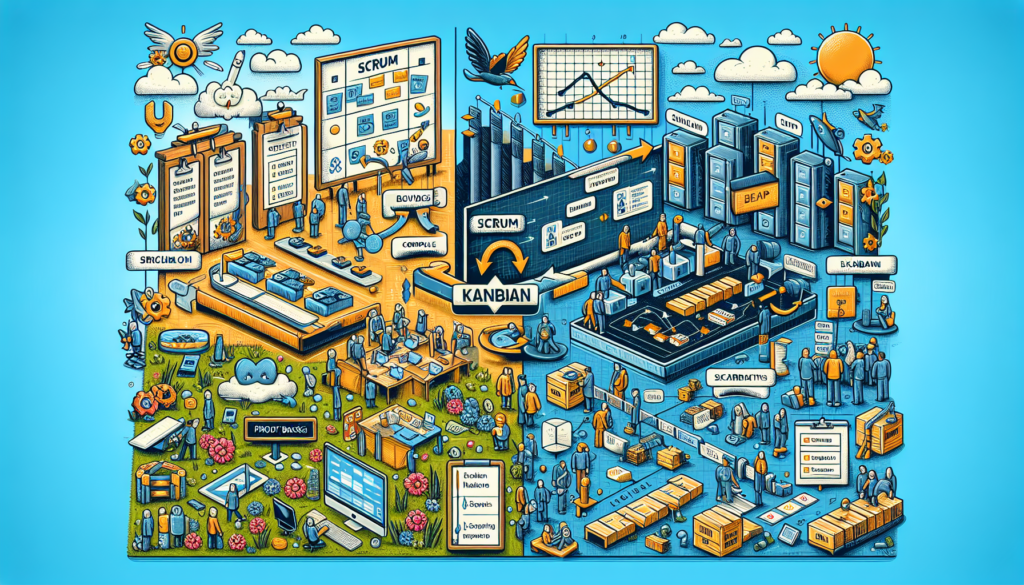In the search for efficiency, flexibility, and speed in the delivery of products and services, various methodologies and frameworks have emerged under the broad umbrella of Agile. With the advent of Agile, software development teams and other disciplines have found innovative ways to address projects marked by uncertainty and change. Among these methodologies, Scrum and Kanban stand out for their popularity and effectiveness, but there are other options worthy of analysis. This article delves into these methodologies, with a special emphasis on their technical characteristics, practical applications, and substantial differences, outlining a clear horizon for organizations focused on improving their project management.
Comparison between Scrum and Kanban
Characteristics of Scrum
Scrum is a framework that fits complex projects, where the final outcome is difficult to predict. This framework promotes the iterative and incremental delivery of products, ensuring frequent deliveries of added value. Distinctive features of Scrum include:
- Sprints: They divide the work into short, consistent cycles, generally two to four weeks long.
- Defined Roles: Scrum Master, Product Owner, and the Development Team.
- Ceremonial Events: Sprint Planning, Sprint Review, Sprint Retrospective, and the Daily Scrum.
- Artifacts: Product Backlog, Sprint Backlog, and Increment, which provide a framework for planning and review.
Characteristics of Kanban
Kanban is a framework inspired by Toyota’s Just-In-Time production system. Its adaptability and focus on workflow efficiency make it an ideal strategy for environments where demands change quickly. Key features of Kanban include:
- Visualization of Work: Using a Kanban board, the workflow is displayed at different stages.
- Limitation of Work in Progress: Limits are set to minimize multitasking and avoid team overcommitment.
- Flow Management: It focuses on smoothing the workflow, reducing cycle time, and eliminating bottlenecks.
- Metrics and Continuous Improvement: Through the analysis of workflow and cycle time, improvements are identified and implemented.
Alternative Agile Methodologies
There are other frameworks within Agile that may be more suitable depending on the project context and organizational culture. For example, Extreme Programming (XP) focuses on software quality and the ability to adapt to changes in customer requirements, even in the later stages of development. On the other hand, Feature-Driven Development (FDD) focuses on modeling and developing features, working in short iterations specifically aimed at value addition.
Practical Applications and Success Stories
The use of Scrum and Kanban has led to multiple success stories where management of time, customer satisfaction, and the quality of the final product have been improved. In the technology sector, companies like Spotify and Google have adapted Scrum to their own needs creating variants that fit their work culture. Other sectors, such as manufacturing and services, successfully apply Kanban to optimize delivery times and quality in their processes.
Case Study Analysis: Agile Transformation at IBM
IBM is a relevant example of how the implementation of Agile practices, including Scrum and Kanban, can lead to significant results. The company faced challenges in speed and flexibility before adopting an Agile culture. By integrating it into their practices, they not only improved efficiency but also boosted employee morale and strengthened collaboration between teams.
Evolution and Future Directions
Looking to the future, it is essential to recognize that these frameworks are not static; they evolve, adapting to new market demands and technology. The incorporation of artificial intelligence and automation in Scrum and Kanban is projected to revolutionize the way projects are managed, allowing for more accurate predictions and improvements in workflow efficiency.
Innovation in Scrum: Scrum@Scale
Scrum@Scale is one of the latest innovations, designed to scale Scrum across an entire organization while maintaining agility and efficiency in large teams. It considers the implementation of Scrum in multiple interconnected teams through the creation of “Scrum of Scrums,” globalizing the methodology at the corporate level.
Innovation in Kanban: Kanban Maturity Model (KMM)
The Kanban Maturity Model (KMM) provides a framework for organizations seeking to develop their Kanban practice progressively. Through seven levels of maturity, from beginner to optimal, the KMM guides companies in expanding their delivery capabilities and improving processes.
In conclusion, Scrum and Kanban are two of the most widespread Agile methodologies whose choice depends on the type of project, organizational culture, and specific team needs. At the same time, the Agile ecosystem continues to be enriched with the emergence of new practices and tools that allow organizations to adapt to increasingly dynamic business environments. Their correct implementation can lead to a remarkable transformation in project management, positioning entities at the forefront of their industry.

